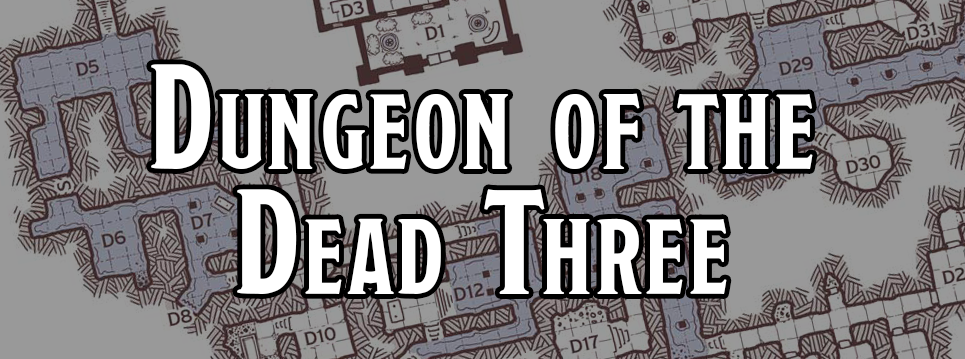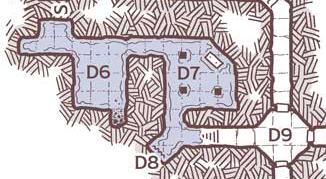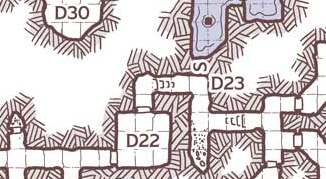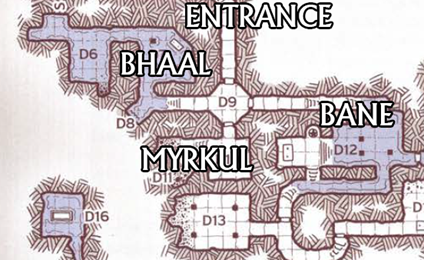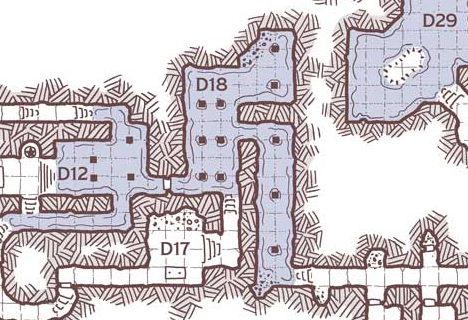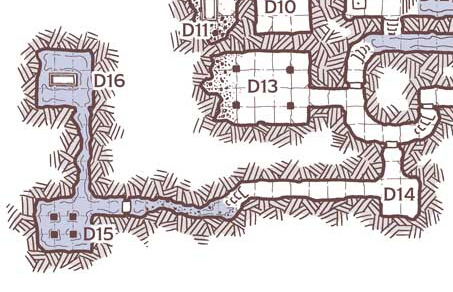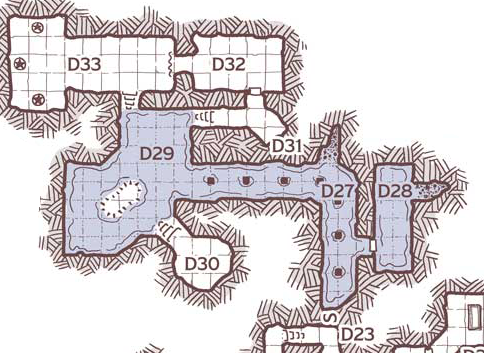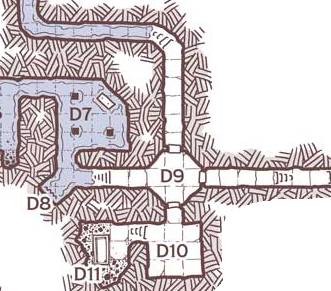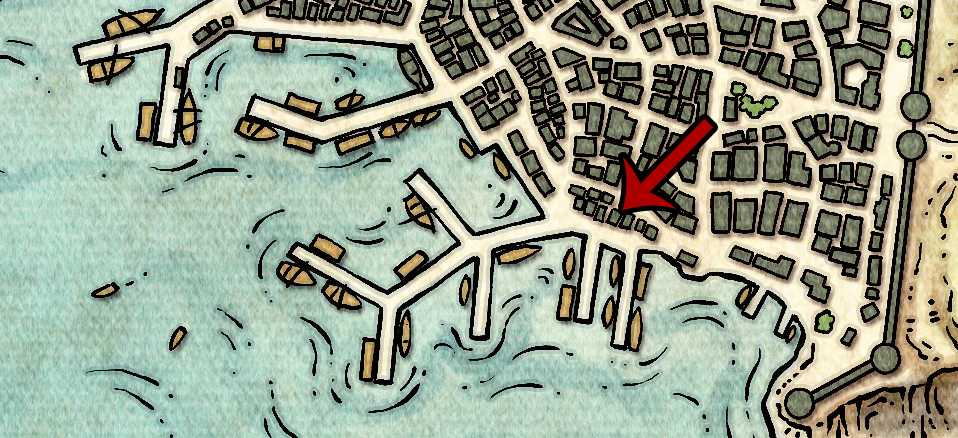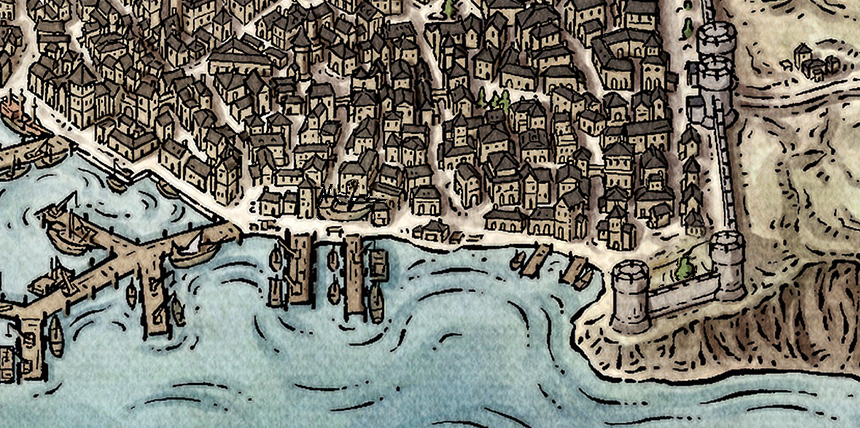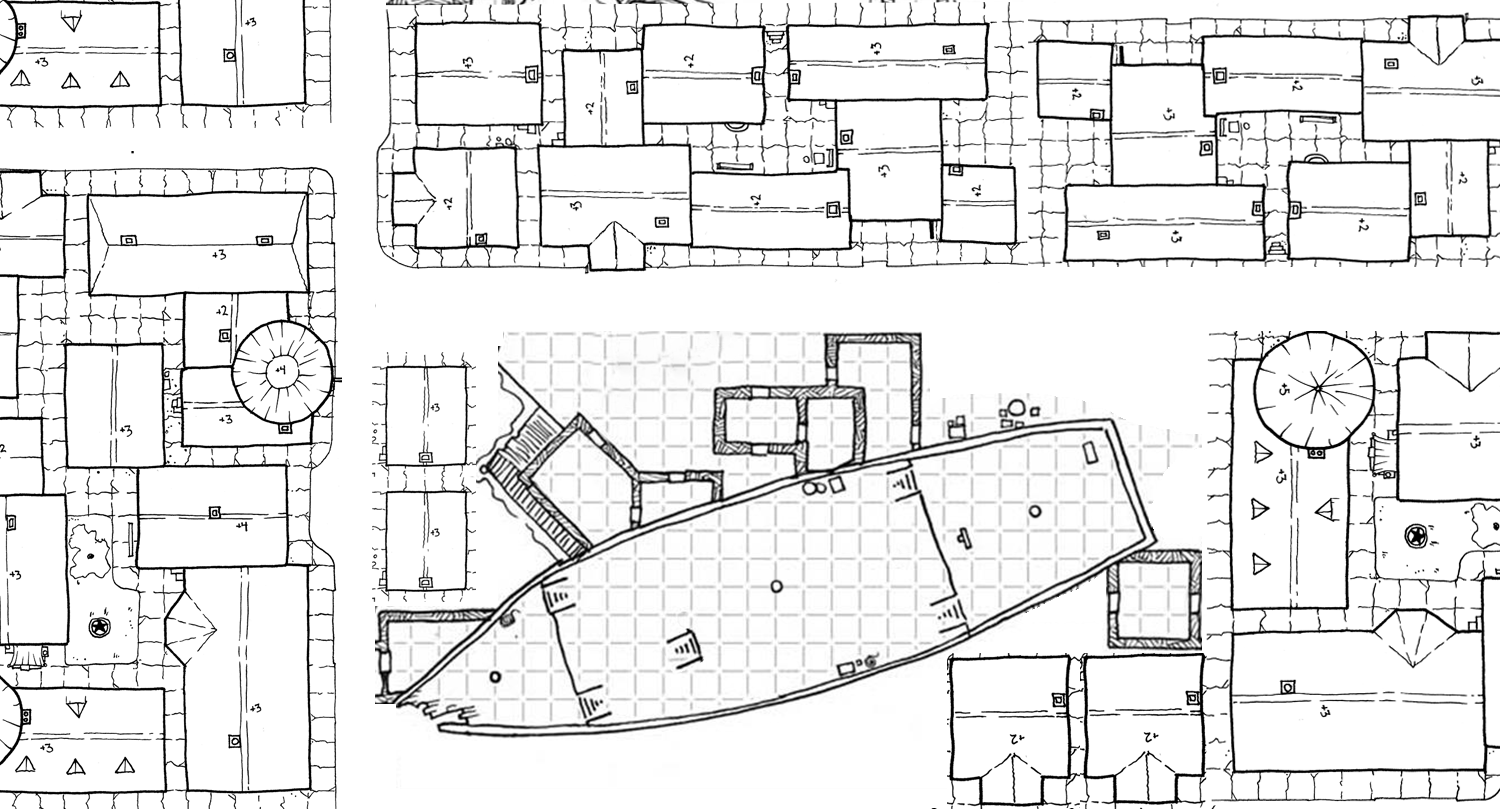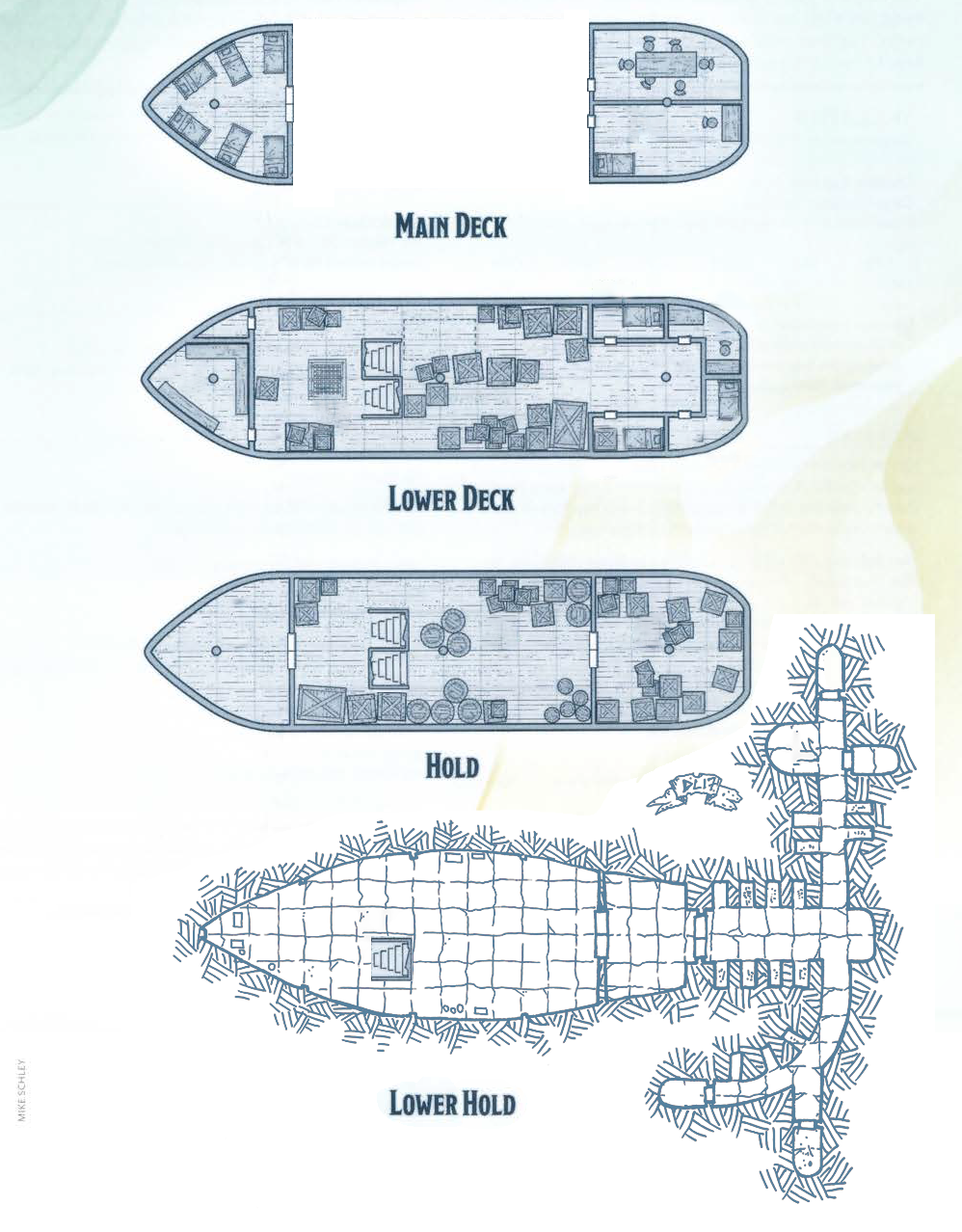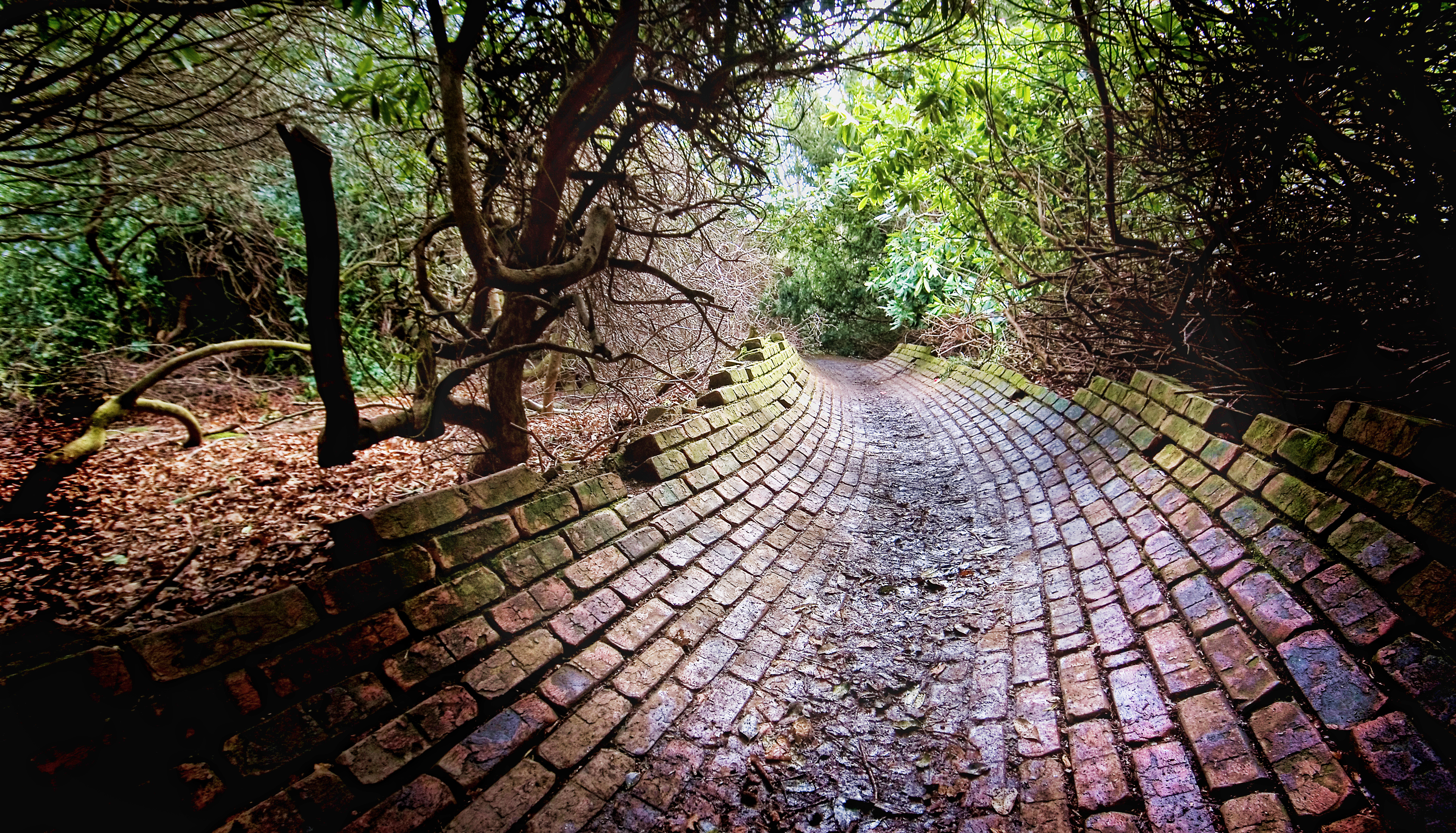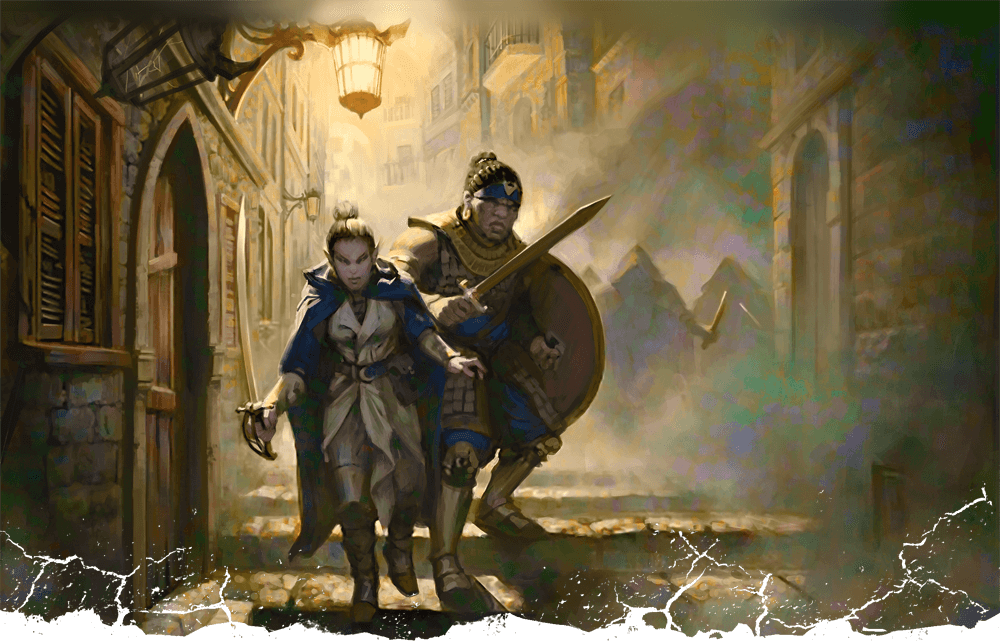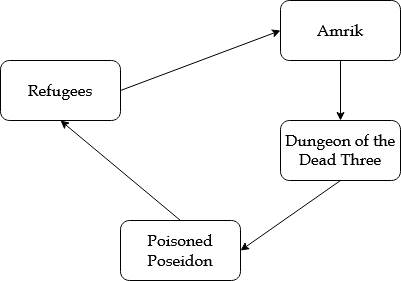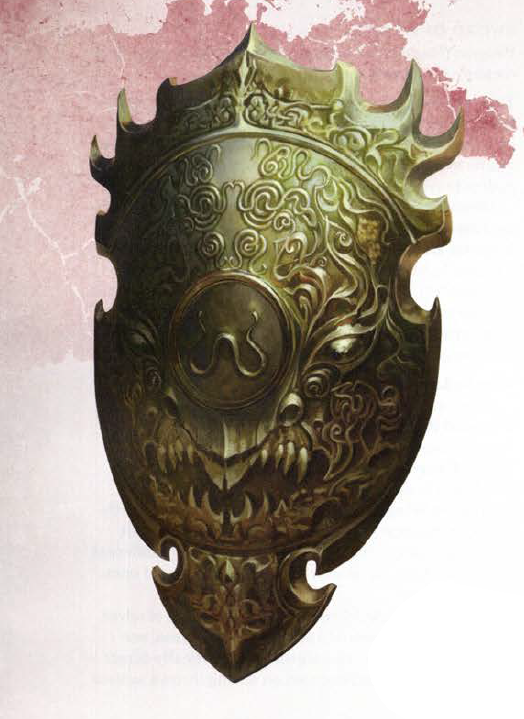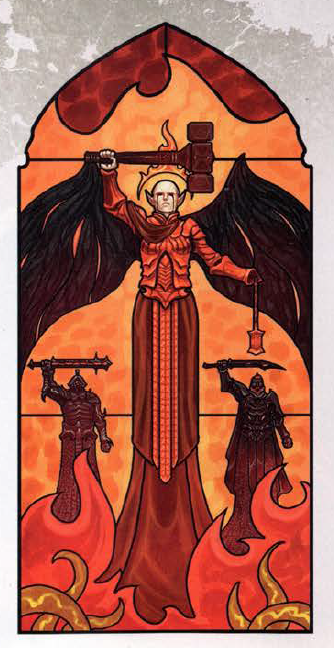The revised background for the Dungeon of the Dead Three is covered in Part 3B: Lore of the Vanthampur Investigations. Short version: Duke Vanthampur discovered an ancient temple dedicated to the Dead Three under the Heapside neighborhood. She sealed off the connections to the sewers and built the Frolicking Nymph bathhouse on top of it in order to create a secret entrance. She has most recently offered the temple to the Dead Three cultists in exchange for their assistance (which currently takes the form of murdering refugees).
There are a number of elements in the Dungeon of the Dead Three that we’re going to be adjusting, polishing, or enhancing. We’ll start by looking at those issues in detail, then present a revised key, and round things out with an adversary roster.
THURSTWELL’S IMP SPIES
We’ll start in the very first room of the dungeon: D1, the Courtyard.
An invisible imp is perched on the southeast fountain. If the characters look as though they intend to cause trouble, the imp observes them quietly until they enter the bathhouse, then flies to Vanthampur Villa in the Upper City to alert Thurstwell Vanthampur, the oldest of Duke Thalamra Vanthampur’s sons. Thurstwell instructs the imp to return to its post but takes no further action, hoping that the characters dispose of his brother, Mortlock
Thurstwell’s imp spies actually turn up several times and they almost always do the same thing: They invisibly watch the PCs while taking no action. Then they fly to Thurstwell and report what they saw. And then Thurstwell doesn’t do anything with that knowledge.
Ever.
My first instinct when seeing an element that’s designed so that the PCs never become aware of it and which has no impact on anything the PCs will do or experience is to just delete it. (It’s actually kind of amazing how many published adventures include this sort of thing.) But there are a couple of clever imp interactions and the central idea of Thurstwell as a crippled spider stuck in his home, able to exercise his will upon the world only through his imp servitors while jealously observing his able-bodied siblings going out and about in the world, is a really great character beat.
So what we really need here is for the imp spies to become meaningful. Which primarily means that Thurstwell needs to take meaningful action in response to what the imps see. A few possibilities:
- He sends an imp to barter with the PCs. (He’d probably like them to kill one or both of his brothers. If he’s feeling daring, or if the PCs have already succeeded at eliminating his brothers, he might even ask them to kill his mother so that he can take her place at the head of the family. If the PCs were to go all in on this, you could have an alternate trajectory where, the job done, he asks them to take the infernal puzzlebox to Candlekeep and have it opened.)
- He sends a murder squad of Dead Three Cultists (Descent Into Avernus, p. 28) to kill the PCs.
- He sends an abduction squad to kidnap a refugee that the PCs care about so that he can use them as leverage. (Maybe to leverage them into an alliance. Maybe to force them to back off.)
Basically, if you play Thurstwell as proactive and Machiavellian, he can either become an unexpected ally or a hated enemy (or both).
WATER LEVELS
There are several text-to-map mismatches in the dungeon, but the most significant are those related to the flooding in the dungeon.
First, Area D8 is described as a “dry alcove”:
In addition to the coloring, the stairs should be placed NORTH of D8, not east.
The design of the dungeon actually does a good job of having the flooded portions of the dungeon consistently lower than the rest of the dungeon. Which is why the failure to color in Area D23 (which is correctly described as flooded in the text) is also an error:
You may want to mark your copy of the map to make sure you get these details right while running the adventure.
THE DEAD THREE DOORS
Let’s take a look at Area D9. There are four passages that lead out of this area: One comes from the entrance, while the others lead to cultists/shrines belonging to one of the Dead Three Gods (Bhaal, Bane, Myrkul).
There are also three doors in Area D9:
- East: Bane
- North: Bhaal
- South: Myrkul
Am I crazy or should the door to the north actually be to the west so that all of the themed doors match the themed content behind them?
In practice, this would mean that the PCs are likely to come in from the entrance and be presented with three creepy doors that they have to interpret and choose and between. Not only is this a cool moment that would set the tone for the entire dungeon, it’s also an opportunity for a meaningful choice. Instead, there’s just a random choice stripped of meaning.
The simple solution here is to just move the door (and you’ll see that in the revised key below), but we’ll also be delving more deeply into the possibilities here in Part 3G: Xandering the Dead Three.
DUNGEON GAS
Area D18 is filled with explosive gas.
The gas has these properties:
- Invisible
- Lighter than air
- Smells like rotten eggs
These are the properties of modern natural gas (which is actually odorless, but since 1880 has had the smell added through the use of an odorant called mercaptan). I’m fairly certain this is not a coincidence, and the designers probably just defaulted to the explosive gas they were most familiar with.
But it’s a choice worth examining. For example, D18 is actually the lowest point in the complex, so it might make more sense to go with a heavier-than-air gas that could CONCENTRATE here, rather than a lighter-than-air gas that dissipates. This would allow you to describe the faint smell elsewhere in the complex where the gas is entering the area (D13, D17, and D19 would be good choices).
This is about more than just being “logical” or having an “accurate simulation” (the layout of the dungeon is designed; you can design it however you want). It’s about meaningful choice and problem-solving: If the PCs can detect the presence of gas leaks before entering Area D18, it gives them the opportunity to gather information and then use that information.
(The adventure kind of does this by saying that any character approaching D18 detects the smell and can make a skill check to recognize its significance. But that’s just a bang-bang interaction; not an opportunity to think, analyze, and make meaningful choices.)
Similarly, D18 is a chokepoint. You have to walk through it to get from one side of the dungeon to the other. “Bringing a lit torch or other open flame into the gas-filled room triggers an explosion…” But: “Followers of the Dead Three carry torches…” Hmm.
The adventure notes that the cultists will extinguish their torches before passing through Area D18, but it’s probably a stronger choice to go one step further here and give them light sources that reflect the environment: Safety lamps or light spells, for example. PCs, seeing this, could realize the danger of an open flame.
In addition to problem-solving, this type of thing also gives the dungeon the feeling of a complete environment rather than just a bunch of disconnected, individual rooms.
So what we’re looking for is a gas with these properties:
- Invisible
- Heavier than air
- Has a distinctive smell (naturally, without the addition of odorants)
In researching safety lamps I discovered that the word dampf, in German, means “vapour.” In England, the term became used to describe a variety of gases encountered during mining:
- Firedamp refers to a flammable gas, most often methane.
- Whitedamp refers to a smothering, toxic gas (usually carbon monoxide resulting from burning coal). This is the gas which canaries were famously used to detect.
- Stinkdamp is hydrogen sulfide. Poisonous, corrosive, and very flammable, with the foul odor of rotten eggs.
- Afterdamp, the toxic mixture of gases left in the aftermath of an explosion. Could be any mixture of the above.
So we can look at that list and identify stinkdamp as the gas we’re looking for.
In remixing the dungeon, however, there are a few more things I’d consider.
First, the risk of an explosion in Area D15. (Looking at the map it seems logical that gas flowing down to D18 would also flow down to D15.) Whether the PCs encounter D18 or D15 first, even if they trigger one explosion they’ll have an opportunity to apply that lesson and avoid the next one. (Or, if they’ve figured out how to avoid the explosions, they potentially get twice the pay-off for it.)
Second, there should be some clear indications that the cultists are trying to fix the gas leak problem. (And probably the sewage flooding the place, too. Yuck. They’re not Moander worshippers.)
Third, I think it would be cool if the cultists were USING the gas for something. Experiments in the Morgue (D13) seem cool. So rather than using stinkdamp, we’re going to use corpsedamp. Usually extracted by necromancers from rotting corpses, corpsedamp can be useful to their work in a number of different ways. I’ve previously written about corpsedamp here, including stats for corpsedamp zombies. So we’ll also swap out some of the skeletons and replace them with these experimental undead.
ELUSIVE MORTLOCK
We’ll talk about this in more detail in Part 3G, but looking at the dungeon on a macro-level it’s relatively easy to see that it’s fairly linear: There are a couple of side branches and a couple of loops, but the design strongly funnels you through the full dungeon to Area D29, where the essential encounter with Mortlock that links you to the next scenario is located.
We talk about some of the other problems with this encounter in Part 3 of the Remix, but the thing to note here, once you identify D29 as the essential Must Have Encounter™ for the adventure to continue, is that the only way to get to Area D29 is through the secret door in Area D23:
I was initially going to describe this as a weird choice, but I think we can realistically describe it as simply being a bad choice. This is something I’ve talked about before, but you’ve created a chokepoint here which makes your scenario very fragile: If the PCs don’t find/go through that secret door, you literally have to toss out the next 232 pages of the book. So a secret door is a bad choice.
But they’ve also sort of tripled down on this bad choice:
- The secret door is in a weird location: Just sitting in the middle of a hallway. That actually makes it far more likely that the PCs will simply never think to look for a door there.
- They’ve put a cultist guard here who, upon spotting the PCs, runs off to a different area. This will have the effect of making the PCs chase him, making it even more likely that they won’t take the time to search this random chunk of hallway.
- They go to oddly great lengths at several points in this dungeon to specifically prevent the PCs from learning about this secret door. (Which, again, is absolutely necessary for the entire campaign to happen.) For example, in Area D14 there is a rat. They actually take the time to specifically tell the DM that if the PCs use speak with animals, this rat DEFINITELY won’t tell them about the secret door.
I’m not a big fan of this kind of needless stonewalling in any case, but here it’s basically perverse.
Now, the work we’ve done revising the revelation lists for the Vanthampur Investigations (see Part 3C) has greatly reduced the fragility of Act I of Descent Into Avernus overall, and this is no longer a Must Have Encounter™. However, it’s still structurally ideal for the PCs to confront Mortlock here: You don’t need to force it to happen, but it also doesn’t make a lot of sense to go out of your way to prevent it from happening.
One way we could remove the fragility of this secret door would be to use the same solution we’ve applied everywhere else: The Three Clue Rule. Simply add three clues pointing to the existence of the secret door, giving the players a robust opportunity to have the revelation that it exists and then track it down.
Another solution might be making it explicit that (a) Mortlock Vanthampur is in the dungeon and (b) you need to confront/kill him. That way if the PCs have seemingly cleared the entire dungeon but HAVEN’T found Mortlock yet, they’ll know that there must be a secret door and they can scour the place until they find it.
But in this case the solution is considerably simpler:
Get rid of the secret door.
There’s absolutely no reason for this door to be a secret door, so just make it a regular door.
CRAMPED CORRIDORS
This is actually not a complaint which I have about the scenario, but one which I’ve seen expressed by a number of GMs (including several who have contacted me directly about it): The Dungeon of the Dead Three is filled with 5-foot-wide corridors and relatively small rooms, and this results in unsatisfactory combat encounters.
I haven’t actually run the scenario (so take this with a grain of salt), but I’ve run enough similar dungeon compounds over the years that my initial reaction to this complaint is strong skepticism. The claustrophobic conditions of a dungeon like this present unique strategic challenges, but it behooves the players to turn those strategic challenges to their advantage (rather than vice versa).
With that being said, to make a dungeon like the Dungeon of the Dead Three really come alive, you need to break the preconception (that’s been subconsciously ground into you by dozens, hundreds, or thousands of encounters from published scenarios) that fights “belong” to a particular keyed room.
For example, if you look at the necromite fight keyed to Area D10:
… that looks like a really boring fight. A 15’ square? With three of those squares being occupied by NPCs?
But what you need to do is recognize that THIS is the real encounter area for the fight:
It’s particularly important to understand this if you’re using a battlemap! It’s very easy to hamstring an interesting encounter by artificially limiting what you actually draw or present as the battlemap for it.
(I talk about these issues more in Running the Campaign: Dungeon as Theater of Operations if you’re interested.)
With all that being said, if this is an issue that concerns you, it looks to me like you can just interpret the map as being drawn at a 10 foot scale instead of a 5 foot scale. Nothing seems to go particularly wonky in doing so.
CULTISTS DOING WEIRD SHIT
Is it weird that one of the cultists has decided to stand guard in D23 “standing in the water” when he could go up the nearby stairs and not have his feet rot off? Yes.
But the cultists down here are doing all kinds of nonsensical shit that I don’t really understand, so maybe it’s just a gimmick that I don’t grok. For example, two days ago they killed a guy and just left his corpse floating in the water for no apparent reason. Or there’s the room where three cultists are lying on the floor “pretending to be dead”… just for fun? On the off-chance somebody chooses this precise moment to stop by?
I don’t get it. Maybe you do. But if you don’t, it’s something you might want to think about before running the dungeon.
DEAD THREE LEADERS
One subtle thing that I almost forgot to talk about because I actually did it subconsciously: Although the local leaders of the Dead Three cults do appear to be named in Descent Into Avernus (Yignath, Flennis, and Vaaz), only one of them is explicitly identified as such. The Remix not only calls particular attention to their identity for the benefit of the DM, it also gives some methods for the PCs to learn their identities.
Identifying the leaders isn’t strictly essential, so I didn’t bother doing a full Three Clue Rule work up for it, but you’ll note that I’ve dropped their names into various pieces of correspondence and you should also make a point of having cultists blabber them out when questioned.
Giving the players an opportunity to figure out the bad guys’ hierarchy here will give them a target list to aim for. This not only gives them the satisfaction of figuring something out, it also gives the Dungeon of the Dead Three a structure in play that’s just slightly more meaningful than “clear the dungeon” (even if, in actual practice, they still end up clearing every room).
TIAMAT TREASURE
There’s this weird little, somewhat abortive subplot here where the Vanthampurs have somehow stolen treasure from the hoard of Tiamat in Avernus. Some of the treasure is here in the Dungeon of the Dead Three and some of it is in Vanthampur Manor. As the PCs leave the dungeon, they encounter Tiamat cultists who have come to retrieve the treasure.
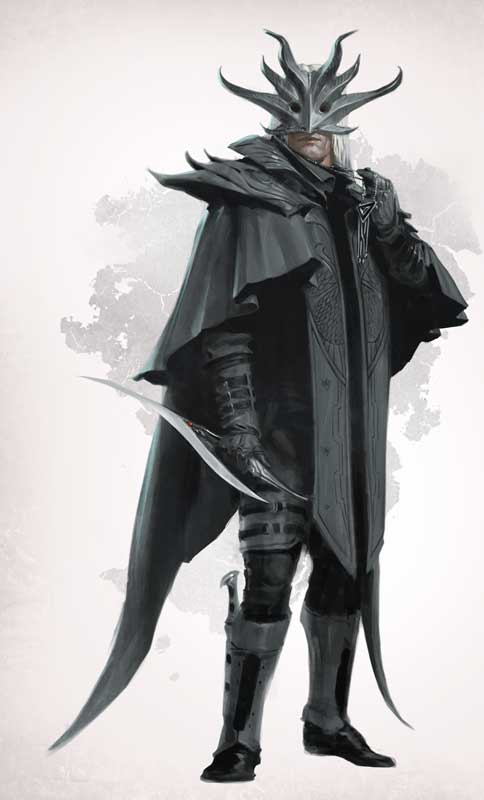 The original intention appears to have been for this stolen treasure to be a significant plot point (Descent Into Avernus, p. 6): “By returning her stolen treasure, characters can convince Tiamat to break Elturel’s chains.” But it seems to have been dropped at some point during development (although mentioned in this opening summary, the treasure doesn’t actually factor into any negotiations the PCs have with Tiamat later in the scenario), leaving only some weird vestigial bits.
The original intention appears to have been for this stolen treasure to be a significant plot point (Descent Into Avernus, p. 6): “By returning her stolen treasure, characters can convince Tiamat to break Elturel’s chains.” But it seems to have been dropped at some point during development (although mentioned in this opening summary, the treasure doesn’t actually factor into any negotiations the PCs have with Tiamat later in the scenario), leaving only some weird vestigial bits.
OPTION #1: My initial inclination was to basically finish expurgating the material from the adventure by removing the encounter with the Tiamat cultists and just not caring about where the cultists’ treasury came from. It feels like very little (if anything) is lost if you do this, and you can easily just excise the encounter if you’d like.
ESTABLISHING LORE: However, I did see an opportunity to use the Tiamat relic in the treasury to establish the key piece of lore that Tiamat is imprisoned in Avernus (since she will factor into the Avernus section of the campaign).
WHERE DID THE TREASURE COME FROM? The explanation (and significance) of how and why the treasure was stolen from Tiamat’s hoard appears to have been lost at some point during the campaign’s revision. Rebuilding all of that from scratch is probably more complication than I’m interested in dealing with, and if you’re going with Option #1 it’s largely irrelevant.
However, some of the additional material added to the Remix established that the Dead Three cult leader Yignath is easily distracted and may be pursuing projects other than the refugee murders. I decided this would include a burglary at Hhune Manor, in which he stole this treasure and also kidnapped Satiir Thione-Hhune. Mortlock allowed Yignath to keep the money, but has sent Satiir to Vanthampur Manor to be used as political leverage.
(Because the Shield of the Hidden Lord is no longer stolen from the Hhunes in the Remix, this also explains Satiir’s presence in Vanthampur Manor.)
OPTION #2: Having done all this, I realized that the Tiamat cultists had suddenly become both relevant and interesting again. In this option, the Hhune treasures included a number of Tiamat-related artifacts, including two pieces — a mask and a crown (see relevant lore below) — that were deeply desired by Arkhan the Cruel. Wards of the Hhune vaults had long hidden them from Arkhan’s sight, but once they were removed from the vault they became vulnerable and the cultists were sent to retrieve them.
- The cultists’ interest in the artifacts will direct or redirect the PCs attention to them, allowing us to emphasize the key piece of lore.
- If the PCs are aware that the mask has been removed from the cache and taken to Vanthampur Manor, they may be able to convince the Tiamat cultists to assist them in raiding the manor.
- Alternatively, the Tiamat cultists might figure out where the mask is independently and complicate the PCs’ raid by executing their own raid at the same time.
- If the PCs assist the cultists in retrieving the artifacts, they are thanked “on behalf of Arkhan the Cruel.” If they encounter Arkhan when they travel to Avernus, he will be more inclined to aid them.
RELEVANT TIAMAT LORE: The full history of Tiamat is a twisted knot that I’m not going to attempt to unravel at the moment. There are three key facts:
- She once ruled Avernus, but the evil dragons born of the vast spawning pits she created proved ineffective in the Blood War and Asmodeus deposed her. (This epoch of Avernus would have predated even Gargauth’s rule by eons.)
- Tiamat is somehow imprisoned in her lair, which also guards the entrance from Avernus to Dis, the second layer of Hell.
- In the Year of the Bloodbird (1346 DR), Untheric cultists successfully summoned an aspect of Tiamat in the form of the Dark Lady. When the Dark Lady first appeared, she wore a simple crown and mask. It is, in fact, this crown and mask which the cultists seek. (They have no magical powers; they are merely historical curiosities held in great reverence by those who have pledged their fealty to the Dragon Queen.)

